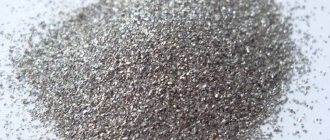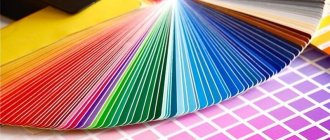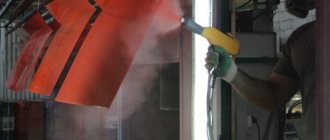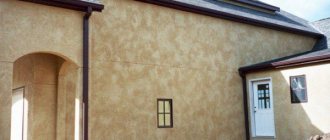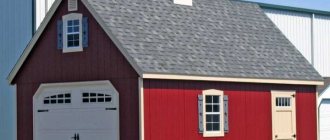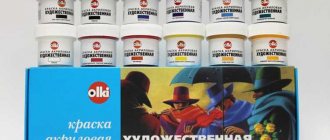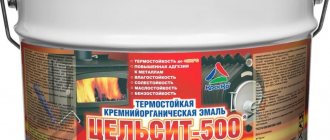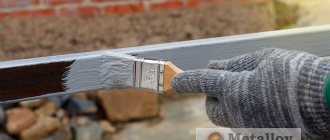Painting is considered the simplest option for finishing a room. And it’s not only about the availability of material for work, but also about the tools used. A roller or brush is used for painting. They make it easy to treat any surface. However, there is a more advanced and modern painting option - use a paint sprayer or spray gun.
Such equipment has many advantages and is widely used for both large and small objects. The equipment is expensive, but it will allow you to complete finishing work on premises and parts tens of times faster and with better quality. There are different types of spray guns, differing in price and characteristics. Before choosing one of the options, you need to consider the advantages of use, the characteristics of each type and the principle of working with the tool.
Pros of painting walls with a spray gun
A spray gun is equipment that consists of a compressor, a receiver and additional elements. The compressor supplies compressed air and pushes the paint out of the gun nozzle. The gun has a paint reservoir at the top or bottom. There are models in which the tank is larger and is a separate element. The paint passes through the receiver nozzle and is applied to the surface. This is the principle of operation of any spray gun. The photo below shows the design of the pistol:
Advantages over roller and brush:
- Application quality. The layer turns out smooth, thin, without drips or visible transitions.
- Reduced consumption of paint and varnish material. Surprisingly, 20–40% less material is used.
- You can use the spray gun for whitewashing, applying varnish, antiseptic or finishing putty, and not just for paint and varnish material.
- Ideal surface. No streaks form on the walls, no brush hairs or visible streaks remain. True, to get the maximum quality of painting, you need to be able to work with a spray gun.
- High speed of work completion. The device is used for finishing large buildings for good reason, because the work can be completed several times faster. Paint application is automated; all that remains is to control the nozzle while applying a layer.
Depending on the device parameters, the operating speed can reach 400 m2/h.
The tool is intended primarily for painting large rooms or an entire complex. If you only need to treat one small room or apartment, it is irrational to buy expensive equipment for this. In addition, you need to learn how to work with it correctly.
Types of spray guns and their prices
All existing spray guns are divided into the following types:
Pneumatic
They provide the highest quality work and are intended for professional use.
Drops of paint escaping from the nozzle are broken into fine dust by air currents due to the special design of the spray head.
As a result, the jet takes the form of a torch, which emerges from the nozzle as a cone.
Structurally, there are models with a lower and upper tank.
However, both options differ only in ease of use in specific conditions.
For example, spray guns with a tank on top are better suited for working with viscous liquids, as they ensure their natural flow to the receiving hole.
These include the so-called mini spray gun, which is shorter due to the fact that the tank is located above the gun.
Low pressure (HVLP), high pressure (HP) spray technologies and a symbiosis of these options combining their advantages (LVLP) are predominantly used.
A characteristic feature is that the spray gun is connected by an air hose to a compressor with a receiver.
The cost starts from 700 rubles. for simple models, it can exceed 7 thousand rubles, and this does not take into account the cost of the compressor.
Mechanical
They are made in the form of a cylinder with a plunger pump, from which hoses come out for pumping the solution and directly spraying it.
Such models are called manual.
Another design option is a spray bottle, where liquid is poured into a container that is hermetically sealed, and then pressure is manually pumped into it with a pump.
The price is around 4 - 5 thousand rubles.
Electrical
It is based on an electric motor.
There are backpack models with spacious tanks and regular small ones.
Their average volume is 5 liters. The cost of the simplest models is 1,300 rubles, and the average price is around 2 – 4 thousand rubles.
The latter, in turn, are divided by type of nutrition into:
• Network – powered from a household electrical network. They can be monolithic or separate, where a hose is used to connect the motor unit to the spray gun.
• Rechargeable – powered by a rechargeable battery. The advantages include the ability to work in places without electricity supply.
There is also a division according to the type of spraying into:
• Airless spraying - material is supplied to the nozzle by a powerful piston pump. A piston spray gun is an obvious name for such models. The special design of the nozzle breaks the paint into small particles. During operation, there is no paint mist, but the paint itself is applied in a relatively thick layer.
• Air atomization – based on a turbine or solenoid motor. The operating principle is similar to pneumatic models. Less common options include powder spray guns, where the guns, which are supplied with electric current, are simultaneously connected to a compressor (electrostatic method).
There are also tribostatic options, where paint particles are charged by friction with each other.
The paint sprayer can be divided into:
- Automotive – for the most accurate and even application of paintwork. This includes airbrushes.
- Construction – for working with paints, various mortars, including primers, in conditions that do not require extremely high precision of application. A paint spray gun allows you to treat areas, such as walls, that are inaccessible to a brush or roller.
- A food spray gun is a power tool that works on the principle of a spray gun.
Used primarily in cooking for coating baked goods such as icing and butter.
Types of spray guns
All products are divided into 3 large groups, depending on the technology for supplying paint and varnish material:
- A hand-held spray gun in which the mixture is pumped using a handle;
- Electric spray gun operating from a 220V power supply;
- Pneumatic type, powered by an external compressor.
Choosing a spray gun is an important step. It all comes down to goals and required performance. And cost also plays a big role.
Operating principle
Mechanical models of hand-held spray guns have a simple design, this is one of the important advantages. The device includes a small number of metal or plastic parts and various gaskets that can be easily replaced if worn out. A manual spray gun, unlike pneumatic models, works using the airless paint supply method. The paint and varnish material that will be sprayed is first pumped into a special sealed container, the composition is pushed out of this container under pressure, and the pressure is created using a hand pump. The spray gun consists of the following elements:
- removable base, which includes a pressure-injecting mechanism and a paint suction device. Two different valves come out of this base - one is needed to suck in the paint and varnish composition, and the other is for supplying paint or whitewash;
- a body having a cylindrical shape, paint is supplied into this body and subsequently it passes through the discharge valve;
- handles with a special plunger pump, which is located in the central part of the device body. The handle with the pump is the main part of the entire structure.
In addition to all the above-mentioned parts of a hand-held spray gun, which perform the bulk of the work, these devices cannot function properly unless they have special equipment. Each device includes two different hoses - one pumps the liquid, and the other sucks the mixture. The suction hose is most often much shorter than the discharge hose.
The spraying process is carried out using a “fishing rod” on which a nozzle and a trigger are located. Many models of spray guns allow you to extend the rod by adding screw-on sections. Thanks to the extension, you can conveniently paint ceilings and apply spray compositions to tall trees.
Each structural element of a hand-held spray gun has a thread for connection with other parts. To clean, repair the device or replace gaskets, you can very easily and quickly disassemble the spray gun
It is important to remember that during the assembly of all elements, the threaded connections must be lubricated with a special lubricant
Hand spray guns
One of the best options for treating small spaces. It is designed for spraying water-based paints and for working with whitewash. Productivity is average, about 250 m2/h. It operates at a maximum operating pressure of 0.6 mPa, so it cannot work with high-viscosity compounds such as varnish and putty.
Important! A manual spray gun can work with both paint and liquid antiseptics or fire retardants. In addition, it is used as a garden spray to protect the crop from pests.
The peculiarity of the equipment is its simplicity. Operation is possible due to mechanical action on the handle. The body is cylindrical; inside there is a plunger pump controlled by a handle. By moving up and down, the pump pumps air and paint is released from the nozzle. The lower part of the body is equipped with a paint container with two connected hoses: for pressure and for suction. The suction hose has a filter at the end to prevent the instrument from becoming clogged. And the valve will not allow paint to return to the equipment.
There is a nozzle at the end of the gun or fishing rod. It can be adjusted to control the spray angle. At the opposite end of the fishing rod there is a trigger, also known as a shut-off valve.
Advantages of applying paint to the surface using manual equipment:
- Minimum cost of the device.
- Simplicity of design and its reliability.
- Mobility, the tool does not need to be connected to a stationary outlet or compressor.
- There is a long adjustable rod that makes it convenient to paint the ceiling without a ladder.
Disadvantages of a manual sprayer:
- low productivity;
- one assistant is required for work;
- You cannot use all types of paints and varnishes (only with minimal viscosity).
Otherwise, a manual spray gun is a good budget option if the room being treated is small. It is convenient to use it at the dacha, paint the facade of the house, fence, trees and spray plants.
Electric spray guns
The main difference from the previous version is the absence of a mechanical handle. Inside the equipment there is an electric pump powered by the network. The tool is easier to use and more efficient.
The scope of use is large, since the viscosity of the paint for the spray gun practically does not matter. They are used for application:
- varnish;
- acrylic and oil based paints;
- priming solutions, even resin-based ones;
- antiseptics;
- whitewash and water-based paints.
Electric spray guns can be divided into two groups:
- Air.
- Airless (membrane).
Air
The peculiarity is in its design: in one body there is both a sprayer and a mechanism that provides air pressure. The equipment is used for paints and varnishes whose viscosity is low.
Advantages:
- Excellent coloring quality, a thin layer of paint and varnish material is formed.
- Mobility of equipment, allowing you to paint objects from a distance.
- There is a power selection.
Flaws:
- formation, during operation, of paint mist;
- the supercharger does not have a receiver, the engine will constantly work, making a lot of noise.
Inexpensive air sprayers have a simple design: a body, a spray nozzle, a control button and a paint tank. The tank can be attached to the handle: from above, from below.
Attention! You can make such a device with your own hands from a vacuum cleaner.
Airless
A universal option for applying paint and varnish material. The equipment allows you to work with compounds of different viscosities. The paint supply to the nozzle is provided by a piston pump. It creates high pressure, while the paint is sprayed through the nozzle design. Drops of paint and varnish material are broken into small particles. If you need universal and mobile equipment, then this paint sprayer is a good option.
Advantages:
- Works without forming paint mist.
- The pump is located in a separate housing or on the spray gun.
- It has a low cost.
Flaws:
- a thick layer of paint is applied to the wall, the consumption increases;
- Although the device is universal, it is recommended to dilute the paint material;
- The quality of painting with such an electric spray gun is not at the highest level.
Advantages and disadvantages
The positive aspects of using spray mechanisms are the following: - the process of repairing and painting a wide variety of surfaces is greatly facilitated in terms of time and effort; — it is possible to achieve the highest quality coverage of complex planes, with irregularities, bends and corners that are difficult to paint with a roller; — the tools are minimal: a bucket of paint, equipment and electricity; — the work is carried out non-stop and does not require constant replenishment of paint in the tank due to the presence of a hose lowered directly into the barrel or jar; - high efficiency in painting large spaces - facades, walls, fences, floors.
The disadvantages of such painting methods include, first of all, the high speed of paint supply under high pressure, which leads to high consumption of raw materials. Working with a device such as a paint sprayer requires skill and experience. For a novice painter, the process will be slow, the distribution of the paint layer will be uneven, with drips. But practice and long-term use will soon allow you to learn how to work with the device accurately, using all its capabilities to the maximum and achieving high-quality coverage.
Pneumatic spray guns
Professional type products consist of a compressor and a receiver. The gun has a nozzle, a trigger and a paint container. The pressure in the receiver can be maintained by the operation of the compressor. The power and productivity of the equipment is selected depending on the volume of work. After pressing the trigger or button, compressed air is supplied to the body itself and the container with paint and varnish material. The increased pressure pushes the fluid out. It passes through the nozzle and a torch is formed. It is possible to adjust its angle by changing the diameter of the nozzle with a special regulator.
Advice! Choosing such a spray gun is not an easy task. For a consistent and uninterrupted process, you need not only a high-quality gun, but also a receiver with a compressor.
Advantages:
- Speed of work, approximately 400 m2/h.
- Easy setup and use.
- Possibility of fine adjustment.
- The pressure is constant, the paint is applied in a thin and even layer.
Minuses:
- high price;
- requires proper selection of compressor;
- not all of the paint and varnish material ends up on the wall, a small amount remains in the air, and material consumption increases;
- Applicable only to liquid paints and varnishes.
A pneumatic spray gun for painting walls is divided into four main types. They have almost the same principle of operation, the only difference is the force of the required pressure. Kinds:
- HP – High Pressure.
- HVLP – (high volume, low pressure) High Volume Low Pressure.
- LVLP – (low volume, low pressure) Low Volume Low Pressure.
- RP – (reduced pressure) Reduced Pressure.
HP – high pressure
Equipment with this technology is low cost and simple in design. Used for many jobs with different materials. Previously, it was often used to paint walls with your own hands. Working pressure – 5–6 bar. Air consumption is small. Features allow you to get the job done quickly.
True, the devices have a low level of paint transfer, it is 40–50%. Only half of all the paint will fall on the wall, the rest will float in the air. Overconsumption of paint and varnish material is doubled.
Advantages:
- Low cost.
- Good coloring quality.
- Speed of work.
Flaws:
- low paint transfer rate;
- A powerful compressor is required;
- To achieve the optimal layer thickness, you need to do several layers.
Today, due to wasteful application, high-pressure spray paint is becoming increasingly rare.
HVLP – low pressure, high volume
Highly effective tools. Air is supplied into it at high pressure, and at the exit it is reduced. The transfer coefficient is 65%, so it is more effective than HP, since only 35% of the substance does not reach the wall.
The torch is stable, so the quality of application is at a decent level. They are economical and affordable. Branded spray gun models will cost from 150 to 350 USD. e. Goods from China have a cost of 40 USD. e.
Advantages:
- Economical. Consumption is reduced by 15% compared to HP.
- The cloud of spray paint is not that big.
- Good quality of application and speed of work.
Flaws:
- high price.
LVLP – low pressure, low volume
The operating pressure is low both at the outlet and at the inlet. Thanks to this, fluid consumption will be minimal, since the transfer is 80%. It’s not for nothing that the system is positioned as super economical.
Since operation does not require a lot of air, the compressor is selected with medium power. At the same time, the speed of painting is also high, as is the quality of application.
Advantages:
- Economical. When working with expensive paint, this is the best option.
- A medium power compressor will do.
- The job was done quickly and the paint applied well and evenly.
Flaws:
- paint mist is still present;
- high price.
RP – reduced pressure
Can be used for any paint or substance. The torch is wide, so you can release a large volume of substance at a time. Spray painting is quick and easy. The layer is perfectly smooth, without flaws. Used to create the best coverage.
Types of paint sprayers
Depending on the method of air supply and device, spray guns for painting ceilings and walls can be divided into three main types:
- manual;
- pneumatic;
- electric.
Manual models
These sprayers have the simplest design, in which the following main elements can be distinguished:
- spray gun;
- pump;
- storage tank.
When work begins, pressure is created in the tank, under the influence of which the paint and varnish material is supplied to the surface to be painted. Spray guns of this type can be equipped with a foot or hand drive. On average, their productivity is 200−250 m2/h.
The main advantages of such units are:
- ease of operation,
- no need for additional costs for air injection,
- possibility of applying water-based, water-lime and water-chalk coatings.
But manual models also have a number of significant disadvantages:
- to create a uniform and high-quality coating, you constantly have to press the lever;
- low productivity;
- low blood pressure, prone to changes;
- Suitable for applying only certain paint materials.
https://youtube.com/watch?v=0GgnbljEodY
If we compare these sprayers with other types, their quality of work is quite low. But, in any case, painting the surface with a hand-held paint sprayer will be faster than with a regular roller. This unit is perfect for painting small areas and rooms for temporary use.
Pneumatic spray guns
A distinctive feature of these devices is the ability to create an even and thin layer on large surfaces. Pneumatic spray guns have the following advantages:
- high performance;
- allow you to quickly paint a large surface area;
- the ability to fine-tune operating parameters;
- stable pressure ensures uniform application of paint and varnish material;
- Suitable for applying any composition.
Among the disadvantages of these devices, we can note the need to additionally purchase a compressor, without which such a spray gun for painting will not work. They are equipped with fairly short hoses that limit freedom of movement.
Additionally, pneumatic paint sprayers can be divided into several subtypes depending on their design features:
- with bottom feed;
- with top feed;
- with high blood pressure;
- with low pressure and high volume;
- with low pressure and volume;
- with a reduced pressure system.
We advise you to study - Corrugated sheeting for a fence - which one is better to choose, taking into account the operating conditions
Electrical devices
The main feature of these units is that all the work is done by a pump, which creates a certain pressure, due to which the paint and varnish material is sprayed onto the surface. Since there is no compressor that would supply compressed air under pressure, the paint is crushed quite poorly. This causes the low quality of the created coating.
Electric spray guns are most often chosen by self-taught craftsmen who decide to do the repairs themselves. Electric paint sprayers are ideal for this task due to their low price and compact dimensions.
Other advantages of these sprayers include the following:
- simple controls;
- allow you to fine-tune the spray mode with suitable parameters;
- the possibility of painting at different angles, which is provided by a flexible intake tube;
- the ability to create high-quality coverage in a short period of time.
Electric spray guns have only two disadvantages: they require preventative maintenance and regular maintenance.
How to choose the right spray gun
We examined the features of each type of equipment. Now it becomes clear that there is simply no one universal and best product option. They are all good at something. In addition, the object that needs to be painted is taken into account. For example, why buy an expensive pneumatic tool for painting a fence or agricultural building in the country, if it is better to opt for a budget electric spray gun or even a manual one.
When choosing a tool, you should consider the following parameters:
- Type of device (air, airless).
- Operating power.
- Type of coverage.
- Viscosity at which it can work.
- Performance.
- Nozzle diameter.
Let's take a look at some of the best inexpensive air products:
- Model Hammer PRZ150A – about 3 thousand rubles.
- Model Energomash KP-9660R – about 2.9 thousand rubles.
- Model Bosch PFS 55 – about 4.8 thousand rubles.
- Model Hammer PRZ600 – about 3.6 thousand rubles.
Best Professional Air Sprayers:
- Model WAGNER W867E All-Spray - about 19.5 thousand rubles.
- Model Bosch PFS 65 – about 6 thousand rubles.
Best Airless Sprayers:
- Model WAGNER ProjectPro 119 – about 56 thousand rubles.
- Model WAGNER ProjectPro 117 – about 39 thousand rubles.
- Model FIOLENT KR1-260 – about 2 thousand rubles.
- Model ENERGOMASH KP-96120 – about 1.5 thousand rubles.
Classification of spray guns by paint spraying
Comparison of spray patterns for paint transfer efficiency
HP system spray guns
The first type of spray guns that spray paint under high pressure and are marked “HP” are the most common. A special feature of these guns is the high pressure at the outlet of the nozzle (about 1.5 atm), while air must be supplied to the inlet of the spray gun at a pressure of 2.5-5.0 atm. Due to the high pressure, the air speed at the exit of the nozzle is quite high. Because of this, the torch is quite wide, which ensures a more uniform application of the paint layer, and also affects the speed of work. At the same time, the air consumption of the spray gun itself is relatively small, from 100 to 300 l/min.
- The main disadvantage of HP sprayers is the large loss of paint during operation. The high air speed at the exit of the nozzle leads to the fact that upon reaching the surface, drops of paint do not have time to stick to it and simply ricochet. Because of this, approximately 65% of the paint material is lost. The paint that flies off the surface forms a fine mist, which gradually settles on the surrounding surfaces. Only 30-35% of the paint and varnish material is transferred to the surface to be painted.
- Another disadvantage is that during operation, the air flow, pushing away from the surface to be painted, forms air vortices. They capture small particles of debris in the air, press them against a layer of paint, and they stick to it. As a result, after painting, grinding and polishing work will be required.
HVLP spray guns
This is not how HVLP sprayers work. Their outlet air pressure is much lower - about 0.7 atm. At the same time, the inlet pressure remains high - 2.5-3.0 atm. It is possible to achieve a pressure drop due to the special structure of the air channels inside the spray gun.
Video: How to choose a spray gun. Spray systems.
Due to the low outlet pressure, the speed of movement of air with paint particles is much lower. Because of this, drops of paint have time to adhere well to the surface. This achieves a high percentage of paint transfer to the surface - up to 70%; only 30-35% of the paint is lost from ricochet. In this case, there is no formation of vortices, so no additional work is required after painting.
We advise you to study - 48 examples of decorating living room walls with stone
But such a painting process is accompanied by a significant air consumption; the compressor must provide over 360 l/min of air.
An additional disadvantage is the need for a small distance between the spray gun and the surface to be painted. This makes painting difficult-to-reach surfaces and from a distance quite difficult.
LVLP system spray guns
When creating sprayers of the “LVLP” system, the positive qualities of the two types listed above are combined. In such spray guns, the outlet pressure is 0.7-1.2 atm, with an inlet pressure of 1.5-2.0 atm. Thanks to this, it was possible to ensure a high percentage of paint transfer - up to 75% with a low air flow - 15-350 l/min. Therefore, such pistols are now a priority.
How to use a spray gun correctly
The entire process of surface treatment can be divided into several stages: preparation for painting, preparation of the compressor, painting, cleaning.
Preparatory work
First you need to decide on the tools and materials for the work:
personal protective equipment: respirator or mask (since painting walls with a spray gun is accompanied by a mist of paint that does not reach the surface), goggles, gloves and overalls;
- masking tape to protect areas from painting;
- film or cover for furniture if it cannot be taken out;
- compressor with the ability to regulate pressure;
- couplings and air hose;
- spray gun;
- paint and varnish material with solvent;
- primer;
- sandpaper.
First you need to choose a solvent and paint. Oil paints are easiest to use, although latex and acrylic paints can also be sprayed. They are safer and better quality. To give the composition the optimal consistency, a solvent is used, depending on the type of paint.
The next step is surface preparation. All furniture is protected with film or covers, the floor is covered with newspapers. Unpainted surfaces are protected with masking tape. It is necessary to create high-quality ventilation inside the room. Personal protective equipment is used.
When everything is ready, the wall is prepared. The old layer, if any, is removed, the surface is sanded, grease stains, dust and dirt are removed. If oil paint is used, the wall is treated with a solvent; if acrylic or latex paint is used, the wall is treated with soapy water. The final stage is priming the walls.
Compressor preparation
The compressor is turned on to supply the test fluid. While the paint is being prepared, let the device build up pressure. To avoid pressure drops during operation, you need a pressure regulator on the compressor. Indicators are set from 1 to 1.7 atmospheres. The exact data is written in the instructions for the spray gun.
A pneumatic coupling is connected to the equipment. The connection must be reliable. Sometimes you have to use a fume. A little solvent is added to the paint container. It is needed to cover the siphon tube. The dispenser control opens slightly (usually one of the lower screws on the handle). The equipment is tested, only the nozzle is directed into a trash bin or onto an unnecessary surface. Spraying does not occur immediately, the system is filled with liquid, so air will come out of the nozzle, and only then the substance. If the solvent is not supplied, this may indicate a blockage or leak in the siphon tube. Finally, the solvent is removed from the tank.
Coloring
The required amount of paint and varnish material for the wall is mixed. After opening the jar, the contents are mixed. If the substance has been stored for a long time, it is better to strain it so that the clots do not clog the spray gun and the coloring quality is high. By adding solvent, the paint is brought to the optimal consistency.
How to properly dilute paint for a spray gun? The ratio depends on the type of paint, but is usually in the range of 15–20% solvent by volume. Then the flow will be uniform. The paint container or tray is two-thirds full. Everything is ready for painting. The handle is held at a distance of 15–25 cm from the wall. The paint is applied evenly, using movements from top to bottom or from side to side. If you have no experience in applying the composition with a spray gun, it is better to practice on an unnecessary surface.
A jet is released from the nozzle when the trigger is pulled. To prevent drops from forming on the surface, you should not linger in one place for a long time. Each pass should be slightly overlapped with the previous one. Then translucent areas will not form. When the paint runs out, the tank is filled again.
Equipment must not be left with paint on it. To take a break, you need to clean the instrument. Thanks to the quick-release head, this is quite easy to do. The reservoir is removed and the solvent is passed through the spray gun.
After application, the paint must dry. If necessary, apply one or more layers. Although modern paints are made in such a way that one layer will be enough. But to be on the safe side, add extra. If glossy paint or varnish is applied to the surface, then to improve the adhesion of the first layer and the subsequent one, the surface is treated with sandpaper.
Cleaning
Unused paint is discarded. If there are a lot of leftovers, everything is returned to the original container. You just need to write or remember that the composition is already diluted. There is an exception: epoxy compounds or two-component ones cannot be reused.
The siphon tube and container are washed with solvent, and the remaining paint material is washed off. The reservoir is filled 25% with solvent, shaken and everything is passed through the equipment until it is washed out. Masking tape and newspapers are removed from the floor after the paint has dried.
Overview of spray gun systems
There are seven spray systems used in modern spray guns:
- HVLP (high volume transfer at low pressure);
- LVLP (low volume transfer at high pressure);
- LVMP (low volume transfer at medium pressure);
- HP (high pressure spray gun marking);
- MP (medium pressure marking);
- RP (reduced pressure marking);
- HTE (high material transfer).
HVLP spray guns today offer optimal quality, but use a lot of air. If you have a two-piston compressor with an actual capacity of 380 l/min, then working with low-pressure guns becomes problem-free. In this case, the material bounces off the surface less and is transferred in a larger volume.
LVLP and LVMP systems use less air and make do with less efficient compressors. In fact, an HVLP spray gun can also work with such equipment, but then there will certainly be pauses in the work necessary to pump in the required volume of air. This, of course, is inconvenient and not suitable for professional work.
HP system spray guns are the most common among garage painters. Their air consumption is small - from 100 to 300 l/min. Accordingly, they can be connected to inexpensive compressors. But there is also a significant drawback: this type of spray gun transfers only half of the materials, and the rest is sprayed into the air.
So, today car painters, when buying a spray gun, most often make a choice between LVLP and HVLP systems. Professionals often use low-pressure guns because they consume less material, and this in turn affects the cost of painting.
Interesting video: does everything depend on the spray gun?
- Minimum set of equipment for painting car bodies
- Training videos on spray painting a car
- Choosing a tool for high-quality car painting
Additional Tips
To use spray guns correctly, you should follow these tips:
- The paint is applied using vertical or horizontal movements; they cannot be combined to avoid the formation of stripes and uneven texture.
- It is better to read the instructions for the spray gun. It indicates the capacity, viscosity and type of paint to use.
- The sprayer should always be thoroughly washed after use.
- The required amount of paint and varnish material is mixed to cover the entire surface. If there are several batches, it is difficult to guess the shade.
- When working with water-based paints, hot water is used. In this case, acrylic paint is diluted by only 5%. Water temperature is approximately 50 ℃.
Important! Do not remove the air tube while the compressor is running!
We looked at which spray gun is best for painting a particular surface. Knowing the types, advantages and features of each of them, anyone can choose the option that will be best for him. The main thing is to follow the exact instructions from the manufacturer and adhere to the advice of experienced painters. Otherwise, everyone will enjoy working with a spray gun, since the speed of wall processing is maximum, as is the quality.
LVLP system spray gun
It stands for Low Volume Low Pressure - low volume low pressure. This is the next development after HVLP. The lvlp system has a number of advantages. Significantly lower air consumption and even more economical than hvlp. As a result, material transfer increased above 75%. lvlp pneumatic spray guns are able to work even at 1 atmosphere with decent quality. Air consumption is about 200 liters per minute.
Lvlp paint sprayers are convenient to use for spot and small detail repairs. In the absence of a powerful compressor. But it will be difficult to completely paint a car with them.
One of the representatives of the lvlp system is the Taiwanese Star Evo-t spray gun.
Cleaning and washing the spray gun
After finishing painting the car, you need to clean the sprayer of any remaining paint, varnish, primer, base enamel or putty. This must be done immediately, before the material begins to harden.
Cleaning can be divided into non-dismountable and washing with complete disassembly of the instrument. First you need to drain the remaining paint, pour solvent into the tank, close the lid and give it a good chat. Then press the trigger, dirty solvent will begin to flow out. As soon as this happens, the dirty solvent flies out of the tank and clean solvent is poured in. The procedure is repeated until pure solvent begins to flow out. After cleaning, it is recommended to remove the spray head and place it in the solvent tank and leave it there until next use.
Periodically, the surface wash requires cleaning with complete disassembly of the pneumatic tool. Remove the tank, spray head, valves, insides, needle, etc., clean them with solvent with soft brushes and blow with compressed air. The insides of the gun are cleaned with a brush or small brushes.
After assembly, the spray gun is additionally washed with solvent, and the seal of the locking needle is lubricated with a special lubricant. Any type of solvent for cleaning the paint sprayer can be used: 646, 647, etc.
After washing, leave a little solvent in the tank.
Don't forget about safety precautions. When cleaning, you may be poisoned by solvent vapors. Therefore, ensure ventilation.
Which spray gun is better?
Of course, a branded professional one will decorate any painter, but if the painter is “armless”, then even an expensive one will not help. The quality of car painting provided by a well-adjusted inexpensive spray gun (Aurita, Voylet, Gav) in confident hands may be higher than the result of using a professional expensive one by an inexperienced craftsman. It is better to start painting work with a simple and affordable sprayer and only then, as you gain experience, switch to professional models.
As for the do-it-yourself spray gun, I’ll say this unequivocally. Today the market offers a huge selection of paint sprayers; for 500 rubles you can buy a simple Chinese spray gun, so you shouldn’t even bother making a spray gun yourself.
How many spray guns should you have?
Many car painters purchase several guns at once for different materials and purposes. There are spray bottles recommended for base, primer or varnish. The ideal option would be when you can afford three pistols. In this case, you will not have problems with paint particles getting into the varnish that was sprayed before.
Of course, it is not necessary to purchase three spray guns. Many car painters who have one paint gun with a 1.6 nozzle apply all materials from varnish to primer. This requires more effort and time to thoroughly clean the tool after spraying different materials.
When choosing a spray gun, be sure to pay attention to the parameters suitable for your compressor. Or, after purchasing a spray gun, select a compressor for the gun
We advise you to study - How to choose a suspended ceiling depending on the material of manufacture, texture and manufacturer
The main parameter of the compressor is the supply of a certain volume of material at constant pressure while using the tool. There is a basic rule for a good compressor operation: it should produce 2 times more cubic units per minute than the spray gun requires at a given pressure. If the compressor performance is insufficient, good atomization will not be obtained, then the compressor will produce an insufficient amount of air.
Hoses and fittings are also important when choosing a spray gun. If you use a ¼ inch hose, normal air flow will not be possible. Find a good 3/8 diameter hose with built-in fittings with good flow. These preparations will significantly improve the air flow in the hose.
What's the result? Which spray gun to choose for painting a car?
If you plan to paint cars on an ongoing basis and have the necessary budget to purchase a premium spray gun, then buy a good, expensive paint gun. For example, you can choose one of the above brands in the expensive segment. I did just that at one time and did not regret buying an IWATA spray gun, which served me for a long time. Later I changed it to another IWATA model, which produces a wider fan. I have an HVLP spray gun with a nozzle size of 1.4 mm. It copes well with the application of all types of paint products. For primer I use a GAV RECORD 220 sprayer with a 2.2 mm nozzle. This nozzle is enough even for applying liquid putty.
Another option is to buy an inexpensive paint gun of reasonable quality, with a nozzle size suitable for paint, varnish and primer. They can learn how to paint and, in the future, competently decide which spray gun to choose for painting a car and purchase a more expensive spray gun, and leave the old one as a primer.
Remember to ensure that the compressor matches the performance of the spray gun you are purchasing. This is an important point. It is also important to set up the spray gun correctly so that the sprayed material spreads well on the surface, but does not cause smudges. Read about this in the article setting up a spray gun for painting a car.
